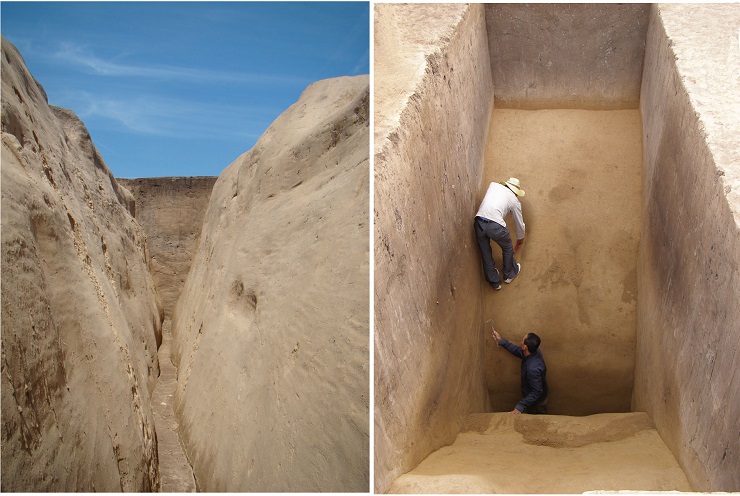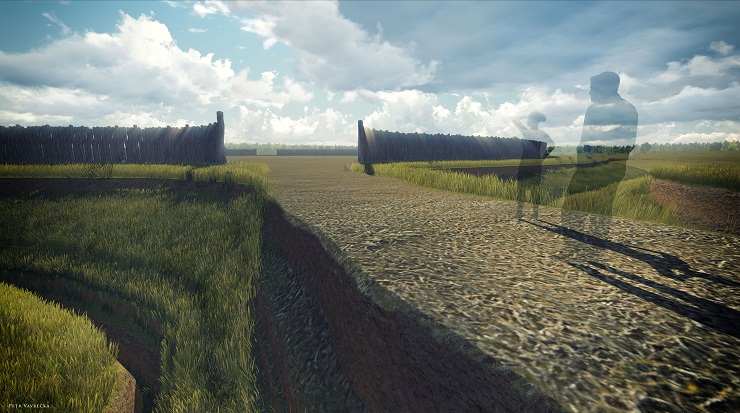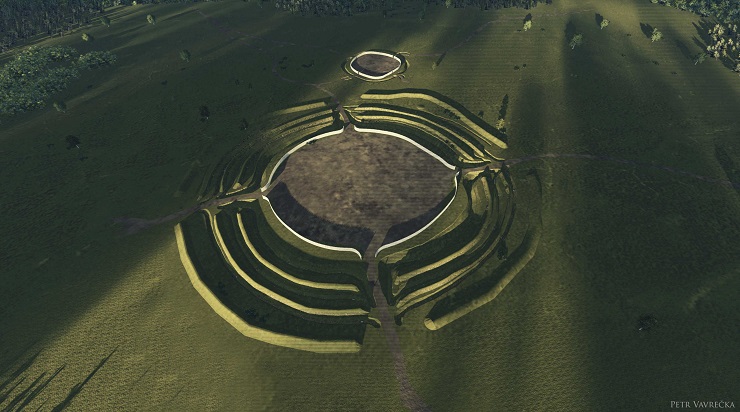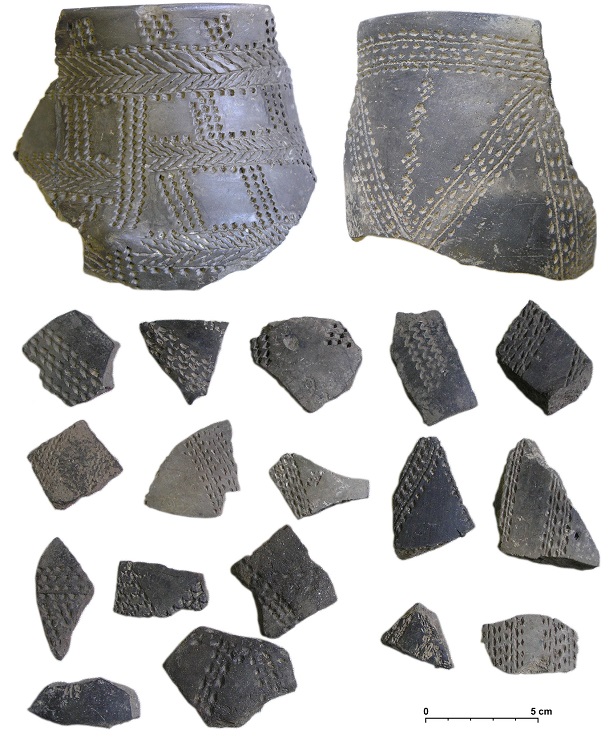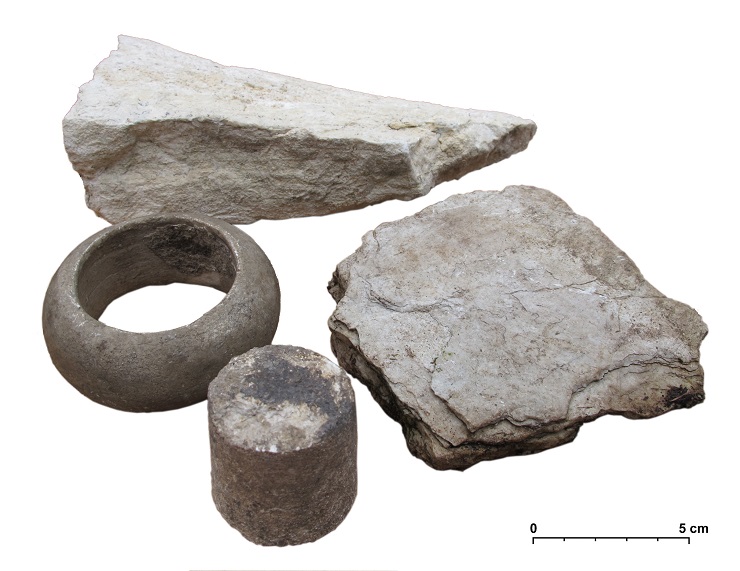If we wanted to name any object, the discovery of which changed our views regarding researching European prehistory in the territory north of the Alps, we would not hesitate to mention the circular trench area from the later period of the Neolithic, which came to be known under the term roundel.
 |
| The groundplans of roundels are variable. What is and are unified, however, is its round shape, its structural parts and the presence of two to six entrances. According to some researchers entrances to roundels were implemented in accordance with the motion of the celestial bodies. Adapted according to Podborský at al. in 1999, Fig. 1. |
What is it actually? Understood as a roundel is a complex of cuspidated trenches of a circular layout (one to four) and of internal circular grooves (one to three), divided by two, three, four (the most frequent) to six entrances. These, with variations, are mostly oriented towards the main cardinal points. The maximum diameter of the entire area generally varies between 30 and 80 metres, however there are also some known roundels (i.e. megaroundels) with a diameter of 100-200 m. The trenches reach a width of two to three metres and a depth of one and a half to three metres. In the case of “megaroundels” these dimensions are also multiplied.
Roundels mainly attract the attention of researchers because of their unified shape, their size, their standard structural elements and their expansion across the fairly extensive area comprising Bavaria, Saxony-Anhalt, passing through Poland, the Czech Republic and Southwestern Slovakia, Western Hungary and Austria. This therefore represents the Central Europe area together with its various archaeological cultures from the late Neolithic period (5000-4400 BC).
|
|
| Apparently the cuspidated trenches of roundels had no practical purpose, moreover, it was difficult to excavate them. A triangular profile represents one of the typical “roundel” features. The images come from researching two trenches of roundel No. 1 prior to the construction of the ring road around Kolín. Photo by R. Šumberová 2008. |
During the archaeological excavations negative imprints of posts were recorded in internal circular grooves, presumably densely packed side-by-side. Presently, therefore, there is a general perception that there were trenches alongside the internal palisade fences (enclosures) that could reach a height of up two metres above ground-level. In this manner a distinctive visual separation was created that enclosed the central area of the roundel for an outside observer. Based on an analysis of the infill of the trenches, it is assumed that around the circumference of the trenches (from their outer side) mounds were placed. Thereby we described the outer appearance of the roundels. But what about their central areas? We cannot say with certainty whether they were roofed or not or whether light structures were built there. For the most part, however, there are no concurrent larger structures located in the centres of the roundels. Of course it is possible that during the use of the campus its reconstruction and expansion took place... Roundels have been unearthed in the context of settlements and therefore they are found within a regular communication zone and daily operations. At some sites a larger number of them was recorded - two to five objects that differ in their appearance.
 |
| Where did roundels first appear and how is it possible that we know them from such a vast territory (pictured green dots) including different Late Neolithic cultures? Some of the researchers believe that the oldest roundels were built in the area of today’s Western Hungary and Lower Austria. From there their know-how was to spread along the Danube River to the west and to the northwest along the Elbe. |
So what purpose did the roundels serve? One of the oldest interpretations is either a defensive function or an enclosure for protecting livestock. In both cases, several entrances appear not to be very advantageous in association with the mounds in front of the trench. In regard to the protection of domestic animals, we would assume that they would be present in most settlements. The newer suggestions include the function of a ritual structure (a shrine), also thanks to the anticipated good acoustics and the covering of the space (the centre of the roundel) from external eyes by means of the palisades. Another possibility is that it was a place in which the movement of the celestial bodies was observed. This somewhat contradicts the divergent number of entrances (which are intended to be placed at the cardinal points) and especially the possibility of roofing-over the central area. Not helping with the interpretation are either the objects found in the infill trenches, probably because they had nothing in common with the actual functioning of the roundel since the trenches were only filled after the termination of the use of the roundel.
|
|
| It is still an open question as to whether it was important to enclose the internal space of roundels to protect them from “public eyes”, or was it the targetted intention of the builders to define the space for specific activities - rituals, games - or ritual games? Author Petr Vavrečka. |
It is evident that the function of the roundel was mainly to gather people. Already during the construction period a considerable number of members of different communities from over a wide area had to meet. There were contacts to be made, ideas to be transmitted, together with innovation and artefacts. This could be what the very purpose of building this “public” architecture is - namely to gather, to unite and to conquer the broader community, declaring both power over and ownership of the privileged classes. At the same time this could also be some sort of symbolic power indicator and the roundel could define the controlled area. One recent hypothesis is the possibility of using roundels for certain forms of ritual games on playing surfaces of the prescribed dimensions.
|
|
| Multiple roundels with mounds located along the outer edges of the trenches constituted unmistakably dominant features of the landscape. Was the central space really free of any lightweight components made of organic materials - and what was the original form of the gates? One computer replica of roundels Nos. 1 and 2, in accordance with the research carried out prior to the construction of the ring road around Kolín. Author Petr Vavrečka. |
|
|
| Vessels richly decorated by means of a multi-tipped tool are typical of the later period of the Stroked Pottery culture. Roundels also appeared on the scene at the same time. The Statenice-Černý Vůl site (Prague-West district). Photo by Jaroslav Řídký 2006. |
|
|
| Raw materials, refuse from after the production and a finished marble bracelet. An exclusive article of the Czech Neolithics? Photo by Jaroslav Řídký 2015. |
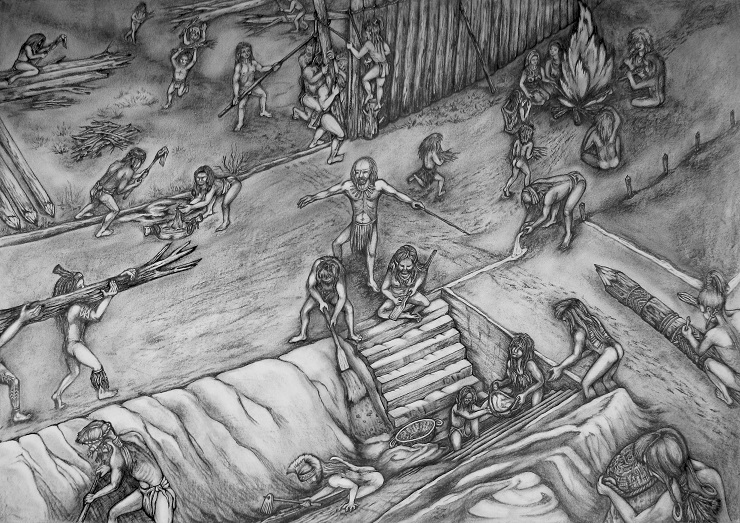 |
| How were roundels created and who was behind their construction? Where are the individuals with exclusive status who managed or initiated the construction buried? A loose reconstruction of the course of the construction of the roundel. Author Isabela Skokanová 2012. |
Want to learn more?
- Květina, P., S. Květinová, and J. Řídký. 2009. Význam her v archaických společnostech. Archeologické možnosti studia. Archeologické rozhledy 61 (1): 3–30.
- Lobisser, W., and W. Neubauer. 2005. Im Kreisgrabenfieber: Experimentalarchäologische Studien zur Bautechnik der mittleren Jungsteinzeit. Archäologie Österreichs 16 (1): 4–17.
- Petrasch, J. 1990. Mittelneolithische Kreisgrabenanlagen in Mitteleuropa. Bericht der Römisch-Germanischen Kommission 71: 498–500.
- Řídký, J. 2011. Rondely a struktura sídelních areálů v mladoneolitickém období. Dissertationes archaeologicae Brunenses/Pragensesque. Praha: Filozofická fakulta Univerzity Karlovy v Praze – Archeologický ústav AV ČR.
- Řídký, J., M. Končelová, R. Šumberová, P. Limburský, and P. Květina. 2014. How were the ditches filled in? Neolithic rondels from the perspective of formative analyses. European Journal of Archaeology 17 (4):579-601.
- Trnka, G. 1997. Zur Bauweise Mittelneolithischer Kreisgrabenanlagen. In Sborník prací filozofické fakulty brněnské univerzity M2, 41–48. Brno: Masarykova univerzita.
 Archeologické 3D virtuální muzeum
Archeologické 3D virtuální muzeum

.png)
